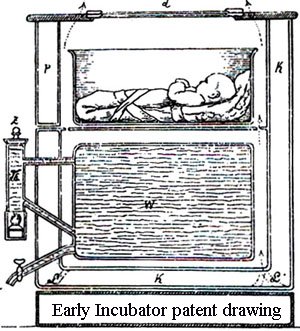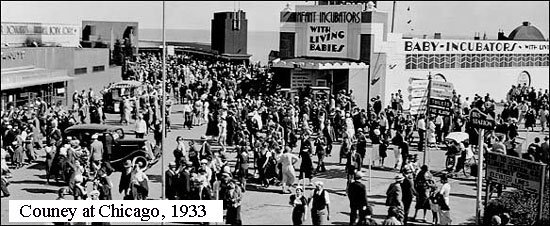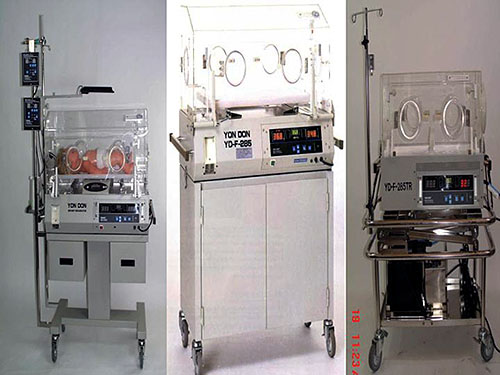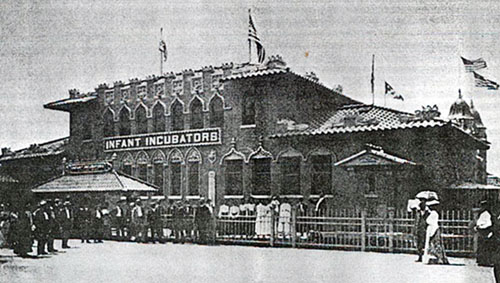Babies in Sideshows
Today, our guest, medical historian Julie Anderson takes us to see premature babies at carnival sideshows. The University of Houston presents this series about the machines that make our civilization run, and the people whose ingenuity created them.
How did premature babies end up being shown alongside Siamese twins and bearded ladies throughout the early twentieth century? The answer is: what started out as a scientific exhibition turned into a public display. Designed to educate doctors and the public alike, the science of incubation became a public spectacle, with premature babies exhibited in incubators all over the world.
 Incubators were first used in Paris hospitals in 1880. The early designs were based on those used to hatch and rear poultry. These incubators, which resembled large boxes, held two infants who were warmed by a hot water chamber underneath.
Incubators were first used in Paris hospitals in 1880. The early designs were based on those used to hatch and rear poultry. These incubators, which resembled large boxes, held two infants who were warmed by a hot water chamber underneath.
Survival rates of the premature babies at the Paris maternity hospitals increased. But how would other doctors find out about this new technology? The answer was to exhibit the incubators at the World Exposition in Berlin in 1896. Six incubators were sent to Berlin with Dr Martin Couney, who persuaded the protectress of Berlin's Charity Hospital, Empress Augusta Victoria, to provide premature infants for the exhibit. Despite having little chance of survival, according to Couney, none of them died.
This exhibition was so successful that it was repeated in London at the Victoria Era Exhibition in 1897. British doctors were not enthusiastic about providing babies, so Couney brought three baskets of premature babies from Paris. As many as 3600 people per day went to see the incubated babies at Earl's Court.
Despite the success of the show in educating the public, critics felt that using small babies in this way was wrong. In 1897, an editorial appeared in The Lancet. It did not criticize the scientific nature of incubation, or question its use at the Exhibition; but it did attack the way that the exhibition attracted public showmen, who would use premature babies in incubators as an unscrupulous way to make money.
Premature babies were exhibited in many cities -- Buffalo, Chicago, Paris St Louis -- in the early part of the century. Martin Couney moved to the United States in 1903 and exhibited babies in incubators at Coney Island every summer. The babies were exhibited without cost to the parents and, as incubation was expensive, many lives were saved. The shows were very popular until 1943 when the exhibition was closed.

Incubation was vital for survival. As well as in exhibitions, these tiny infants appeared in newspapers, their survival, it was reported, dependent on incubators. Oxygenated incubators were used in the 1930s, providing an isolated environment for these babies.
By 1943 the era of premature babies in incubators on public display had ended. New technologies in incubation in the hospital had replaced the marveling public. These infant sideshows educated both medical practitioners and the public.
I'm John Lienhard, at the University of Houston, where we're interested in the way inventive minds work.
 Julie Anderson is a historian of medicine at the Centre for the History of Science, Technology and Medicine at the University of Manchester in England. She has written on medical technologies and disability and war. Her book Surgeons, Manufacturers and Patients: A transatlantic history of total hip replacement is forthcoming with Palgave this month.
Julie Anderson is a historian of medicine at the Centre for the History of Science, Technology and Medicine at the University of Manchester in England. She has written on medical technologies and disability and war. Her book Surgeons, Manufacturers and Patients: A transatlantic history of total hip replacement is forthcoming with Palgave this month.
J. P Baker, The Machine in the Nursery: Incubator Technology and the Origins of Newborn Intensive Care (Baltimore: Johns Hopkins, 1996).
W. A Silverman, Incubator baby Side-shows, Paediatrics, Vol. 64, No. 2, (August 1979).
Some websites on incubators and their history:
Silverman's on-line article
New York Times article
Additional images of early incubators have been kindly provided by UH Medical Historian Helen Valier, CLICK HERE TO SEE THEM.
Images on this page: Dr. Anderson's photo by JHL. Other images from the web are as follows: Early incubator is a patent drawing. Source of photo of Couney's display at the 1933 Chicago World's Fair is unknown. The modern incubator photos are courtesy of incubator manufacturer, Yon Don Enterprise Co., Ltd. The photo of the display at the Pan American Exhibition in Buffalo, 1901, is from Dr. Allen Silverman's excellent site on the history of neonatology.

